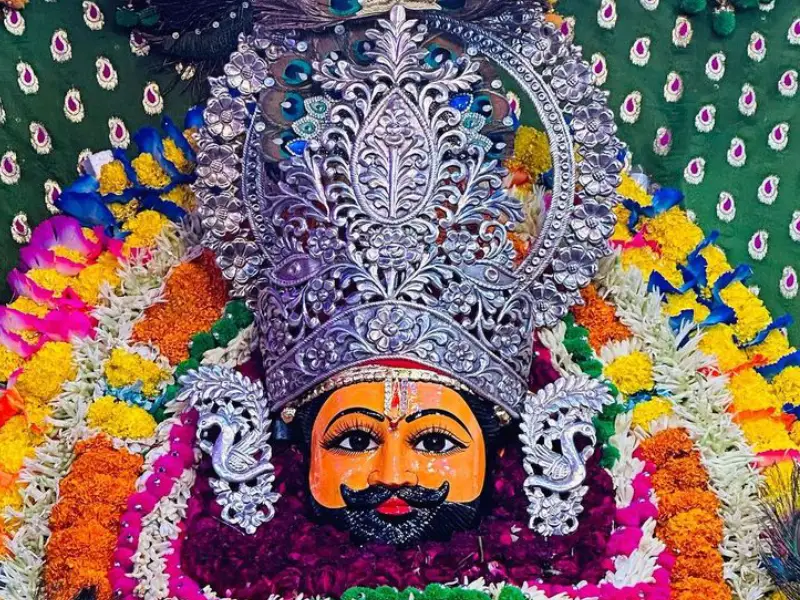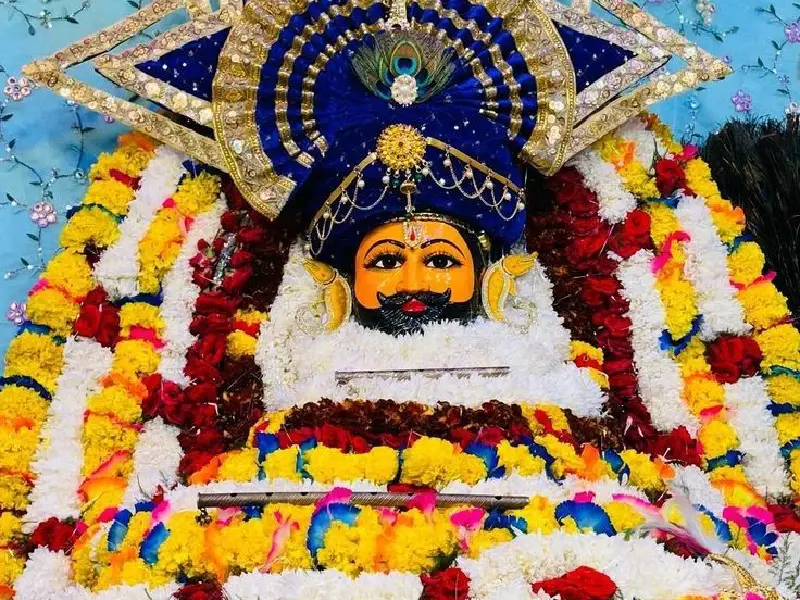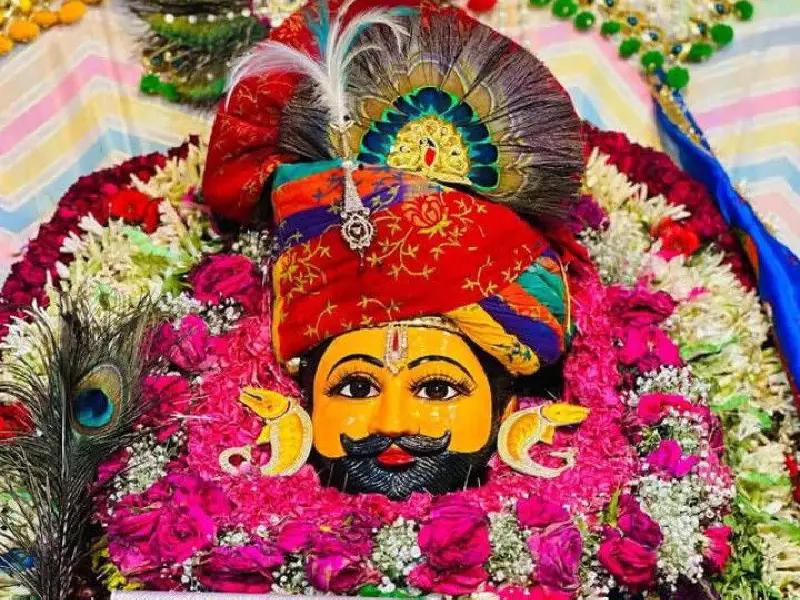Khatu Shyam Ji, also known as Shyam Baba, is one of the most revered deities in Hinduism, particularly in northern India. He is considered the “God of Kaliyuga,” a benevolent lord who grants the wishes of his devotees and guides them through life’s challenges. This detailed guide delves into the history, significance, rituals, festivals, and everything you need to know about Khatu Shyam Ji and his legendary temple.
Who is Khatu Shyam Ji?

Khatu Shyam Ji is believed to be the reincarnation of Barbarik, a legendary warrior from the epic Mahabharata. His story is deeply rooted in the rich mythology of ancient Hinduism, where he is revered for his devotion and the significant role he played in the events leading up to the great war of Kurukshetra.
The Legend of Barbarik:
Barbarik was a warrior blessed with unmatched valor and skill. He possessed three celestial arrows that could destroy any army in moments. Despite his strength, he was humble and deeply devoted to Lord Krishna. Before the Kurukshetra war, Barbarik promised to fight for the weaker side, regardless of who it was. Krishna, recognizing the complexity of Barbarik’s promise, tested him. Barbarik ultimately offered his head as a sacrifice to Krishna, showcasing his unshakable devotion.
Transformation into Shyam Baba:
Impressed by his sacrifice, Krishna blessed Barbarik and gave him the name “Shyam”, symbolizing his dark complexion and divine qualities. Krishna also granted a boon that Barbarik would be worshipped in Kaliyuga and that his devotees’ wishes would be fulfilled.
Khatu Shyam Mandir: A Spiritual Hub

Location:
The temple is situated in Khatu Village, part of the Sikar district in Rajasthan, India.
Temple Architecture:
The Khatu Shyam Temple is a masterpiece of Rajasthani architecture, adorned with intricate marble carvings, golden gateways, and beautifully painted walls. The sanctum sanctorum houses the idol of Shyam Baba, which is made of rare black stone and is adorned with vibrant garlands and jewelry.
History and Origin of the Temple

The origins of the Khatu Shyam Temple trace back to ancient times. According to folklore:
- Discovery of the Idol:
The idol of Shyam Baba was discovered in the Shyam Kund, a holy pond near Khatu village. It is believed to have emerged miraculously when a villager dreamt of its location. - Establishment of the Temple:
The temple was first constructed by the King of Khatu in the 11th century. Over time, it underwent several renovations, with its current structure reflecting exquisite craftsmanship.
Spiritual Significance of Khatu Shyam Ji
- God of Kaliyuga:
Khatu Shyam Ji is considered a guiding force for people in Kaliyuga, offering hope, blessings, and spiritual fulfillment. - Symbol of Sacrifice and Devotion:
His life story highlights the virtues of humility, courage, and unconditional faith in God. - Miracles and Blessings:
Numerous devotees have shared stories of miracles after praying to Shyam Baba, further enhancing his divine aura.
Festivals and Celebrations at Khatu Shyam Temple
Phalgun Mela:
- When: February-March during the Hindu month of Phalgun.
- What Happens:
- This grand annual fair attracts lakhs of devotees.
- The temple is decorated magnificently, and special pujas, bhajans, and kirtans are held.
- Many devotees undertake a walking pilgrimage to the temple during this time.
Ekadashi Celebrations:
- Significance: Ekadashi (the 11th day of the lunar cycle) is considered auspicious for Shyam Baba.
- Rituals: Devotees observe fasts, chant Shyam Baba’s name, and participate in the evening aarti.
Janmashtami:
- Celebrated as Lord Krishna’s birthday, it holds special significance because of Shyam Baba’s connection to Krishna.
Rituals and Practices
- Holy Dip in Shyam Kund:
Devotees take a purifying dip in the sacred Shyam Kund before entering the temple. It is believed to cleanse sins and prepare the devotee for darshan. - Aarti Timings:
- Mangala Aarti: Early morning ritual to wake the deity.
- Bhog Aarti: Midday prayers when food offerings are made.
- Sandhya Aarti: Evening prayers accompanied by devotional music.
- Shayan Aarti: Night prayers before the deity is symbolically put to rest.
- Offering Prasad:
Popular offerings include coconut, sweets, dry fruits, and chana. The prasad is distributed among devotees after the prayers. - Chanting Mantras:
Devotees chant:
“Hare Ka Sahara, Shyam Hamara”
It is believed to invoke blessings and divine energy.
How to Reach Khatu Shyam Temple

By Road:
Khatu village is easily accessible by road. It is well-connected through a network of state highways. If you’re traveling by bus or taxi, you can reach Khatu Shyam Temple from major cities like Jaipur, Sikar, and other surrounding areas. The journey by road is smooth, and you’ll find regular buses and taxis available to take you directly to the temple.
By Train:
The nearest railway station to Khatu Shyam Temple is Ringas Junction, located approximately 17 km away from the temple. Once you arrive at Ringas Junction, you can easily find regular autos and taxis that will take you to the temple. The short drive from the railway station makes it convenient for travelers arriving by train.
By Air:
If you’re flying to Khatu Shyam Temple, the nearest airport is Jaipur International Airport, which is about 80 km from the temple. From the airport, you can hire a taxi or take a private car to reach the temple. The road from Jaipur to Khatu village is well-maintained and offers a comfortable journey.
Accommodation Options Near Khatu Shyam Temple

When visiting Khatu Shyam Temple, there are several accommodation options nearby to ensure a comfortable stay for pilgrims and tourists. Whether you’re looking for budget-friendly options or more luxurious accommodations, you’ll find suitable places to stay around Khatu village.
1. Hotels in Khatu Village:
The area around Khatu Shyam Temple has several small guesthouses and budget hotels offering basic amenities for pilgrims. These hotels typically provide clean rooms, simple meals, and easy access to the temple. Staying here allows you to be close to the temple, making it convenient for early morning prayers and darshan.
2. Hotels in Sikar:
For those looking for more variety in accommodations, Sikar, a nearby city, offers a wide range of hotels, from budget to mid-range and luxury options. Sikar is about 35 km from Khatu Shyam Temple, and many people choose to stay here for better amenities. Popular hotels in Sikar offer comfortable rooms, air conditioning, and services like Wi-Fi, room service, and restaurant facilities.
3. Dharamshalas:
Dharamshalas (pilgrim rest houses) are a popular and affordable option for devotees visiting Khatu Shyam Temple. These rest houses are often managed by temple authorities or local trusts, providing basic but clean and safe lodging for pilgrims. They typically offer shared accommodations and may also provide meals, making them a great choice for those traveling on a budget.
4. Resorts and Lodges:
For those looking for a more comfortable stay with additional amenities, there are a few resorts and lodges near Khatu village and in Sikar. These properties often offer spacious rooms, recreational facilities, and peaceful surroundings, ideal for travelers looking for a relaxing stay. Many resorts also have gardens, restaurants, and event spaces for family gatherings or special occasions.
5. Homestays:
If you want to experience local hospitality, homestays can be a unique and personal option. Some local families in and around Khatu village offer rooms or entire homes for visitors. Staying with a local family can give you a more authentic experience and insight into the local culture, along with home-cooked meals.
Stories of Miracles and Faith
Devotees often share experiences of miraculous healings, fulfillment of wishes, and life-changing moments after visiting Khatu Shyam Ji or chanting his name. These stories strengthen the belief in his divine powers.
Online Darshan and Digital Presence
For devotees unable to visit the temple physically, online darshan through live streams and official temple websites is available. This ensures everyone can stay connected to Shyam Baba, regardless of their location.
Khatu Shyam Ji Bhajans and Music
Devotional songs like “Khatu Naresh Ki Jai Ho” and “Shyam Teri Bansi Pukare” are an integral part of Shyam Baba’s worship. These bhajans uplift the soul and deepen the connection with the deity.
Key Tips for Visiting the Temple
- Timing:
Visit early in the morning or during weekdays to avoid large crowds. - Festivals:
If you wish to experience the grand celebrations, plan your visit during the Phalgun Mela. - Dress Code:
Wear modest and comfortable attire, keeping in mind the sanctity of the place.
Why Visit Khatu Shyam Ji Temple?
Khatu Shyam Ji Temple is not just a religious site but a place filled with divine energy, spiritual significance, and cultural importance. Nestled in Khatu village in Rajasthan, this temple is dedicated to Khatu Shyam Ji, also known as Barbarik, a revered figure in Hindu mythology. Here are some compelling reasons to visit the Khatu Shyam Ji Temple:
1. Spiritual Significance:
Khatu Shyam Ji Temple holds immense spiritual importance for devotees, as it is the abode of Lord Shyam, believed to be the reincarnation of Barbarik, the grandson of Bhima from the Mahabharata. Worshipping at this temple is considered a way to seek the blessings of Lord Krishna and Khatu Shyam Ji, who is known for his ability to fulfill the wishes of his devotees.
2. Divine Blessings and Miracles:
Devotees come to Khatu Shyam Ji Temple seeking blessings for prosperity, health, peace, and success. Many pilgrims report experiencing miraculous occurrences, where their prayers are answered. The temple is believed to grant the divine blessings of Khatu Shyam Ji, who is known for his selfless sacrifice and devotion to Lord Krishna.
3. Historical and Mythological Connection:
Visiting the temple gives you the opportunity to connect with the deep history and mythology of the Mahabharata. The story of Barbarik, his sacrifice, and his rebirth as Khatu Shyam Ji is a powerful tale of devotion, justice, and divine grace. Pilgrims who visit the temple are often reminded of the lessons of selflessness and dedication that Khatu Shyam Ji represents.
4. Peaceful and Serene Atmosphere:
The temple’s peaceful environment offers a perfect setting for meditation, reflection, and inner peace. Surrounded by nature, the temple is located away from the hustle and bustle of city life, making it an ideal place for spiritual rejuvenation. The divine chants, the serene surroundings, and the peaceful ambiance create a soothing atmosphere for all who visit.
5. Cultural and Religious Importance:
Khatu Shyam Ji Temple is an integral part of Rajasthani culture. Pilgrims from all over India, especially from Rajasthan, come here to pay their respects and celebrate various festivals dedicated to Lord Shyam. The Khatu Shyam Mela, a grand festival held every year, attracts thousands of visitors who gather to celebrate with prayers, music, dance, and food.
6. Opportunities for Pilgrims and Devotees:
For those on a spiritual journey, visiting Khatu Shyam Ji Temple offers a chance to seek solace and divine intervention. Many devotees perform special rituals, offer prayers, and seek blessings for their loved ones. The temple also provides a sense of community, where devotees can come together and share their faith.
7. Architectural Beauty:
The temple is not only spiritually significant but also architecturally beautiful. It boasts intricate designs and carvings that reflect the craftsmanship of traditional Rajasthani architecture. The temple’s structure and surrounding area provide a visually appealing environment that adds to the experience of visiting.
8. A Gateway for Pilgrims to Other Temples:
Khatu Shyam Ji Temple is part of the broader pilgrimage circuit in Rajasthan. It serves as a starting point for many pilgrims who wish to explore other nearby temples and sacred sites. The region is known for its spiritual richness, and visiting Khatu Shyam Ji Temple can be part of a larger journey through this holy land.
Conclusion
Khatu Shyam Ji is a beacon of devotion, sacrifice, and divine blessings. The temple’s rich history, vibrant festivals, and miraculous stories make it a must-visit destination for every spiritual seeker.
Make the journey to Khatu Shyam Ji, and you will find your prayers answered and your heart filled with divine grace.
FAQs About Khatu Shyam Ji
Who is Khatu Shyam Ji?
Khatu Shyam Ji is the reincarnation of Barbarik, the grandson of Bhima (one of the Pandavas) and the son of Ghatotkacha. He is a revered deity in Hinduism, known for his immense devotion and sacrifice, particularly during the events of the Mahabharata.
What is the story behind Khatu Shyam Ji?
The story of Khatu Shyam Ji is rooted in the Mahabharata, where Barbarik, a skilled warrior, pledged to fight for the weaker side in the Kurukshetra war. Lord Krishna, to prevent Barbarik from altering the war’s outcome, requested him to offer his head in sacrifice. Barbarik, in his selfless devotion, agreed, and Krishna blessed him with immortality. In Kaliyuga, Barbarik was reborn as Khatu Shyam Ji.
Why is Khatu Shyam Ji also called Barbarik?
Khatu Shyam Ji is the reincarnation of Barbarik, and hence, he is sometimes referred to as Barbarik Shyam. The name represents his previous life as a brave warrior who sacrificed himself for the greater good and continues to be worshipped in his divine form.
Where is the temple of Khatu Shyam Ji located?
The main temple dedicated to Khatu Shyam Ji is located in Khatu Village in Rajasthan, India. It attracts thousands of devotees every year who come to seek the blessings of the deity.
What are the key blessings of Khatu Shyam Ji?
Khatu Shyam Ji is believed to grant his devotees with peace, prosperity, and fulfillment of desires. Worshippers seek his blessings for success in their personal and professional lives, overcoming obstacles, and spiritual growth.
6. How do devotees worship Khatu Shyam Ji?
Devotees typically offer prayers, flowers, and prasad (sacred food offerings) at the temple. Many also chant Shyam Baba’s mantra and participate in aarti (ritual worship), expressing their devotion and seeking divine grace.
7. What is the significance of Khatu Shyam Ji in Hinduism?
Khatu Shyam Ji is considered a deity of devotion, sacrifice, and justice. His story emphasizes selflessness and the importance of fulfilling one’s promises. Devotees believe that by praying to Khatu Shyam Ji, their wishes will be granted and their lives will be blessed with prosperity and peace.
8. What is the connection between Khatu Shyam Ji and Lord Krishna?
Khatu Shyam Ji, as Barbarik, was a devoted follower of Lord Krishna in his previous life. Lord Krishna blessed him after his sacrifice, granting him a special place in Kaliyuga as a deity who can fulfill the wishes of those who worship him with devotion.
9. Can Khatu Shyam Ji’s blessings be received through prayer?
Yes, devotees believe that Khatu Shyam Ji listens to the prayers of those who approach him with a pure heart and genuine devotion. Many devotees report having their wishes fulfilled through prayer and faith in Khatu Shyam Ji.
10. What is the significance of the name “Shyam”?
The name “Shyam” is a reference to Lord Krishna, who is also known as Shyam due to his dark complexion. Khatu Shyam Ji is named after Krishna, emphasizing his connection with the divine and the blessings associated with his worship.
